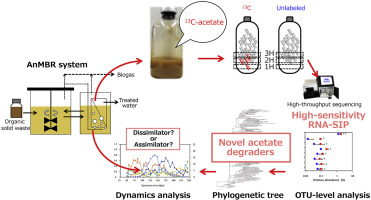当前位置:
X-MOL 学术
›
Water Res.
›
论文详情
Our official English website, www.x-mol.net, welcomes your
feedback! (Note: you will need to create a separate account there.)
Unexpected diversity of acetate degraders in anaerobic membrane bioreactor treating organic solid waste revealed by high-sensitivity stable isotope probing.
Water Research ( IF 11.4 ) Pub Date : 2020-03-29 , DOI: 10.1016/j.watres.2020.115750 Tomo Aoyagi 1 , Tomohiro Inaba 1 , Hidenobu Aizawa 1 , Daisuke Mayumi 2 , Susumu Sakata 2 , Amine Charfi 3 , Changwon Suh 3 , Jong Hoon Lee 3 , Yuya Sato 1 , Atsushi Ogata 1 , Hiroshi Habe 1 , Tomoyuki Hori 1
Water Research ( IF 11.4 ) Pub Date : 2020-03-29 , DOI: 10.1016/j.watres.2020.115750 Tomo Aoyagi 1 , Tomohiro Inaba 1 , Hidenobu Aizawa 1 , Daisuke Mayumi 2 , Susumu Sakata 2 , Amine Charfi 3 , Changwon Suh 3 , Jong Hoon Lee 3 , Yuya Sato 1 , Atsushi Ogata 1 , Hiroshi Habe 1 , Tomoyuki Hori 1
Affiliation

|
In anaerobic membrane bioreactor (AnMBR) treating organic solid waste, acetate is one of the most important precursors to CH4. However, the identity and diversity of anaerobic acetate degraders are largely unknown, possibly due to their slow growth rates and low abundances. Here, we identified acetate-degrading microorganisms in the AnMBR sludges by high-sensitivity stable isotope probing. Degradation of the amended 13C-acetate coincided with production of 13CH4 and 13CO2 during the sludge incubation. High-throughput sequencing of RNA density fractions indicated that the aceticlastic and hydrogenotrophic methanogens, i.e., Methanosaeta sp. (acetate dissimilator) and Methanolinea sp. (acetate assimilator), incorporated 13C-acetate significantly. Remarkably, 22 bacterial species incorporating 13C-acetate were identified, whereas their majority was distantly related to the cultured representatives. Only two of them were the class Deltaproteobacteria-affiliated lineages with syntrophic volatile fatty acid oxidation activities. Phylogenetic tree analysis and population dynamics tracing revealed that novel species of the hydrolyzing and/or fermenting taxa, such as the phyla Bacteroidetes, Chloroflexi and Lentisphaerae, exhibited low relative abundances comparable to that of Methanolinea sp. (0.00011%) during the AnMBR operation, suggesting that these bacteria were involved in anaerobic acetate assimilation. Meanwhile, novel species of the phyla Firmicutes, Synergistetes and Caldiserica, the candidate phyla Aminicenantes and Atribacteria and the candidate division GOUTA4-related clade, as well as the known Deltaproteobacteria members, existed at relatively high abundances (0.00031%-0.31121%) in the reactor, suggesting that these bacterial species participated in anaerobic dissimilation of acetate, e.g., syntrophic acetate oxidation. The results of this study demonstrated the unexpected diversity and ecophysiological features of the anaerobic acetate degraders in the AnMBR treating organic solid waste.
中文翻译:

高灵敏度稳定同位素探测揭示了厌氧膜生物反应器中处理有机固体废物中乙酸降解物的意外多样性。
在处理有机固体废物的厌氧膜生物反应器(AnMBR)中,乙酸盐是CH4最重要的前体之一。但是,厌氧乙酸盐降解物的特性和多样性在很大程度上是未知的,可能是由于它们的生长速度慢和丰度低。在这里,我们通过高灵敏度稳定同位素探测鉴定了AnMBR污泥中的乙酸盐降解微生物。污泥温育期间,修正的13C-乙酸酯的降解与13CH4和13CO2的产生同时发生。RNA密度级分的高通量测序表明,该菌株具有破弹性和氢营养性产甲烷菌,即Methanosaeta sp。(乙酸异化剂)和Methanolinea sp。(乙酸酯同化剂),明显掺入13C-乙酸酯。值得注意的是,鉴定出22种掺入13C-乙酸盐的细菌,而他们的大多数与培养的代表有很远的联系。它们中只有两个是具有腐殖酸挥发性脂肪酸氧化活性的Deltaproteobacteria附属的谱系。系统进化树分析和种群动态追踪显示,水解和/或发酵类群的新物种,如拟杆菌,叶绿假单胞菌和香茅,具有相对较低的相对丰度,可与甲醇甲醇相比。(0.00011%)在AnMBR手术期间,表明这些细菌参与了厌氧乙酸同化。同时,出现了新菌种Firmacutes,Synergistetes和Caldiserica,候选菌种Aminicenantes和Atribacteria以及候选GOUTA4相关的进化枝以及已知的Deltaproteobacteria成员,存在于反应器中的丰度相对较高(0.00031%-0.31121%),这表明这些细菌物种参与了乙酸的厌氧异化作用,例如,共生乙酸的氧化。这项研究的结果表明,厌氧乙酸盐降解剂在AnMBR处理有机固体废物中具有出乎意料的多样性和生理生态特征。
更新日期:2020-03-30
中文翻译:

高灵敏度稳定同位素探测揭示了厌氧膜生物反应器中处理有机固体废物中乙酸降解物的意外多样性。
在处理有机固体废物的厌氧膜生物反应器(AnMBR)中,乙酸盐是CH4最重要的前体之一。但是,厌氧乙酸盐降解物的特性和多样性在很大程度上是未知的,可能是由于它们的生长速度慢和丰度低。在这里,我们通过高灵敏度稳定同位素探测鉴定了AnMBR污泥中的乙酸盐降解微生物。污泥温育期间,修正的13C-乙酸酯的降解与13CH4和13CO2的产生同时发生。RNA密度级分的高通量测序表明,该菌株具有破弹性和氢营养性产甲烷菌,即Methanosaeta sp。(乙酸异化剂)和Methanolinea sp。(乙酸酯同化剂),明显掺入13C-乙酸酯。值得注意的是,鉴定出22种掺入13C-乙酸盐的细菌,而他们的大多数与培养的代表有很远的联系。它们中只有两个是具有腐殖酸挥发性脂肪酸氧化活性的Deltaproteobacteria附属的谱系。系统进化树分析和种群动态追踪显示,水解和/或发酵类群的新物种,如拟杆菌,叶绿假单胞菌和香茅,具有相对较低的相对丰度,可与甲醇甲醇相比。(0.00011%)在AnMBR手术期间,表明这些细菌参与了厌氧乙酸同化。同时,出现了新菌种Firmacutes,Synergistetes和Caldiserica,候选菌种Aminicenantes和Atribacteria以及候选GOUTA4相关的进化枝以及已知的Deltaproteobacteria成员,存在于反应器中的丰度相对较高(0.00031%-0.31121%),这表明这些细菌物种参与了乙酸的厌氧异化作用,例如,共生乙酸的氧化。这项研究的结果表明,厌氧乙酸盐降解剂在AnMBR处理有机固体废物中具有出乎意料的多样性和生理生态特征。











































 京公网安备 11010802027423号
京公网安备 11010802027423号